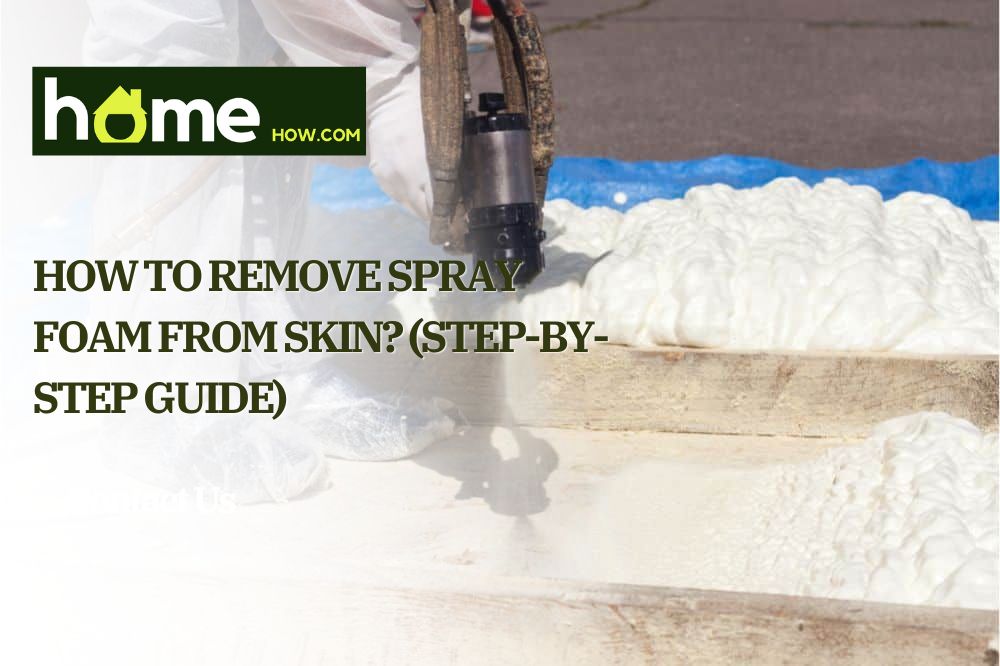If you’ve ever pondered the question, “how to remove spray foam from skin?” you’re certainly not alone. It can be tricky, and if you’re not careful, it can have negative consequences.
This guide will walk you through the steps for a safe, quick, and effective means of removing spray foam from your skin. As professionals, we’re here to ensure you get the best results possible from this guide.
That said, let’s jump right in!
Tools You Need to Get Started
If you want to remove spray foam insulation from the skin, below are the necessary tool required to make that happen:
- Rubber gloves
- Disposable cloth
- Paper towel
- Soft brush
- Soap and water
- Acetone
- Cotton wool or a piece of cloth
- A pumice stone or nail file
- Isopropyl alcohol
- Petroleum jelly or moisturizing cream
- Plastic cling film
Three Methods on How to Remove Spray Foam From the Skin
Removing spray foam from your skin can be a tricky, daunting task. But with the right supplies and preparation, it can be a breeze.
The guide below highlights some of the best methods available to help you get the spray foam off your skin.
Method 1: How to Remove Spray Foam From the Skin Using Alcohol and Paper Towels
 This is one of the most straightforward methods since it requires easily accessible materials. Here’s how to go about it.
This is one of the most straightforward methods since it requires easily accessible materials. Here’s how to go about it.
Step 1: Get the right supplies.
In the process of removing spray foam from the skin, it’s crucial to have the right supplies to ensure you’re tackling the job safely and thoroughly. You’ll need items like dish soap, rubbing alcohol, paper towels, and a soft brush.
Step 2: Prep the affected area.
Now that you’re ready to clean the affected area, the next step is to prep it to make the application easier and more effective. You’d do that by removing any loose pieces of dried foam still stuck to the skin — a soft brush is best for this as it protects the skin from damage.
Step 3: Remove the stubborn remnants.
Once the excess is gone, it’s time to take out the remaining stubborn expanding foam. Begin by wetting a paper towel with dish soap and warm water. Rub this paper towel over the area, using light pressure to help break down any remaining foam and dead skin. If needed, use a few drops of rubbing alcohol to help dissolve the foam. Once the foam has been eliminated, rinse the area with warm soapy water and pat dry.
Step 4: Moisturize the area.
Finally, moisturize the skin to help protect it from any irritation or possible infection. Applying a natural moisturizer like vegetable oil or aloe vera should do the trick, leaving your skin feeling soft and nourished.
In cases where you can’t get alcohol, what other methods are available? Read on to see how you can achieve similar results without alcohol.
Method 2: How to Remove Spray Foam From the Skin Using Acetone

If you’ve accidentally gotten excess spray foam on your skin, don’t panic. Acetone is a powerful solvent that can quickly break down and remove this sticky substance from your skin.
Here’s a step-by-step DIY guide on how to do it:
Step 1: Safety first (Protect your hands).
The first thing to do before initiating the process is to protect your skin. Acetone is a powerful chemical liquid that can cause damage to your bare skin. So, ensure you avoid direct contact by wearing a plastic glove; if you have direct contact by any means, ensure you wash it away immediately.
Step 2: Clean the affected area with acetone.
Dip a piece of cotton or a cloth in the acetone solution and carefully cover the area sprayed with foam. This area would have hardened, so let it sit for a few minutes while the acetone breaks down the foam.
Step 3: Remove the dissolved foam from the skin.
After waiting a few minutes, the spray foam should have been noticeably softened. So, gently rub the cloth against the area to remove the foam. At this point, the skin is quite sensitive, so take your time during this process.
Step 4: Wash off.
Use an exfoliating soap and warm water to rinse the area. This will help you eliminate any residue left by the acetone. If you’re dealing with stubborn foam, you may need to repeat the process.
Step 5: Moisturize the area.
After undergoing the above process, dab the skin area with a paper towel to get it moisturized and damp. Then, take out a bit of moisturizing agent, which could be Vaseline, a body or hand lotion. Apply this sufficiently to help soothe the affected area.
Method 3: How to Remove Spray Foam From the Skin Using Pumice Stone

If you’ve found yourself with spray foam on your skin and don’t have access to acetone or alcohol, we still have something for you. Also, this method is a great alternative if you don’t want to apply chemicals to your skin. Pumice stone is a gentle yet effective way of removing spray foam without damaging your skin.
Here’s a step-by-step guide on how to go about it:
Step 1: Prep the pumice stone.
Start by wetting the pumice stone with water. You’re trying to create the same effect as when using it on a calloused heel.
Step 2: Wash the affected area.
Gently scrub the area affected with dried spray foam using the pumice stone. You can use a nail file as a substitute for a pumice stone. Ensure you wear gloves and take your time when washing the affected areas. Move in circles to effectively break down the foam. Since the stone can be rough and may affect your skin, you shouldn’t apply excessive force while at it.
Step 3: Rinse off the area.
Once the foam has broken down, use soap and warm water to rinse the area. This will help you eliminate any residue and ensure the skin is completely clean.
Step 4: Cure the affected area.
Now that the skin is dry, apply petroleum jelly or lanolin to the affected area. You can massage it in to ensure it soothes the surface. Next, wrap the affected area in a plastic cling film and allow it to sit for close to one hour. Then repeat the processes in step 3.
Step 5: Moisturize
Finally, apply a layer of petroleum jelly to help your skin regain its radiance. You could also apply a bit of moisturizer later to help with hydration.
Pro tip: Avoid scrubbing too hard. This is an important tip to remember, as scrubbing too hard can cause irritation or even damage the skin.
If the foam doesn’t come off, try hot water instead of cold water. The heat from the water will help break down the foam more quickly and make it easier to remove.
Finally, apply a moisturizer before and after removing the foam to ensure your skin is hydrated and healthy.
It’s important to note that these aren’t the only methods available to remove spray foam from your hands, wrist, or skin. Methods such as using baby powder, baking soda, nail polish remover, and lacquer thinner such as Goo Gone or Goof Off are also quite common.
Extended Tips: 6 Tips to Help Keep You Safe When Using Spray Foams
If you need to use polyurethane foam for any project, it’s essential to take the necessary precautions to avoid getting it on your skin. Mistakes happen; this is why we’ve devised a preventive measure to help you avoid contact with spray foams.
Here are a few tips on how to do this:
- Wear protective gear: Protective gear such as chemical-resistant gloves and a protective face mask plays a pivotal role in your safety and should be worn while using spray foam. Since spray foam residue can be easily blown around during application, these gears are designed to protect your skin from any damage.
- Apply it in a well-ventilated area: Spray foams are made from polyurethane, a material that hardens quickly and can be hazardous. Once the chemicals get into the air, they can be easily inhaled, thereby getting into your lungs and causing damage. So, it’s vital to restrict application to well-ventilated areas despite wearing protective gear.
- Clean up spills immediately: Accidents can happen when using foam sealants. So ensure you immediately remove any spill that may have occurred with a damp cloth.
- Have a first-aid kit nearby: It’s important to have a first-aid kit close to you should any accidents happen. This should include items like antiseptic wipes, gauze, and bandages. When dealing with spray foam, other first-aid items needed include damp cloths, isopropyl alcohol, and moisturizers to help get the skin hydrated.
- Practice spraying from a distance: Try to keep a safe distance between you and the area you’re spraying with foam sealant; this will help reduce the risk of getting it on your skin.
- Read the directions carefully: Read the manufacturer’s instructions before using the spray foam. Be sure to follow all safety precautions outlined in the manual.
Conclusion
This guide has provided a comprehensive overview of the best methods for safely removing spray foam from the skin. Whether you choose to use alcohol, acetone, or pumice stone, always remember to take all necessary safety precautions. Lastly, remember to moisturize the area after using any of these methods to help soothe and protect the skin. If you have any questions, please leave a comment below.
